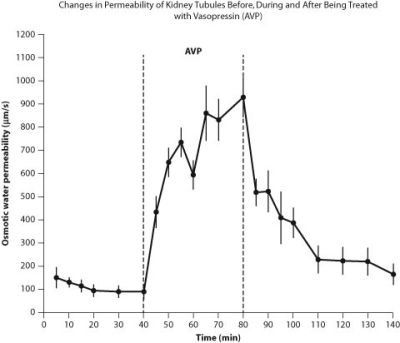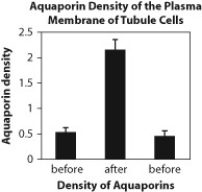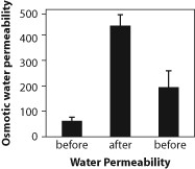Water movement is important in urine formation in the kidneys. Urine is formed when the blood is filtered by the kidneys into kidney tubules. Three figures are presented here that relate to how the kidney tubules respond to the administration of the hormone vasopressin. The direction that water flows in these figures is from the kidney tubules back into the blood.
 Figure A. Changes in permeability of tubules in the kidney in response to the hormone vasopressin (AVP) , which aids in osmoregulation.
Figure A. Changes in permeability of tubules in the kidney in response to the hormone vasopressin (AVP) , which aids in osmoregulation.
 Figure B. Density of aquaporins in kidney tubule cells before, during, and after administration of vasopressin.
Figure B. Density of aquaporins in kidney tubule cells before, during, and after administration of vasopressin.
 Figure C. Permeability of tissues to water before, during, and after administration of vasopressin.
Figure C. Permeability of tissues to water before, during, and after administration of vasopressin.
-Using the data from the graphs and what you know about membranes and metabolic pathways, predict which of the following is the likely reason why actions of aquaporins in a membrane can change so rapidly.
A) The number of aquaporins in the membrane is constant, but the pores have to be activated.
B) Aquaporins are inserted into the membrane as needed.
C) Aquaporins are only in cells that need to be permeable to water.
D) Aquaporins use ATP to pump water across the membrane, and their action is limited by the metabolic pathways that produce ATP.
Correct Answer:
Verified
Q58: The active site of an enzyme is
A)
Q59: Which of the following direct energy transfers
Q60: When a cell uses chemical energy to
Q61: Water movement is important in urine formation
Q62: Heating inactivates enzymes by
A) breaking the covalent
Q64: Americans spend up to $100 billion annually
Q65: Water movement is important in urine formation
Q66: Which part of the ATP molecule breaks
Q67: Which of the following is a coenzyme?
A)
Q68: Lipase is an enzyme released by the
Unlock this Answer For Free Now!
View this answer and more for free by performing one of the following actions

Scan the QR code to install the App and get 2 free unlocks

Unlock quizzes for free by uploading documents